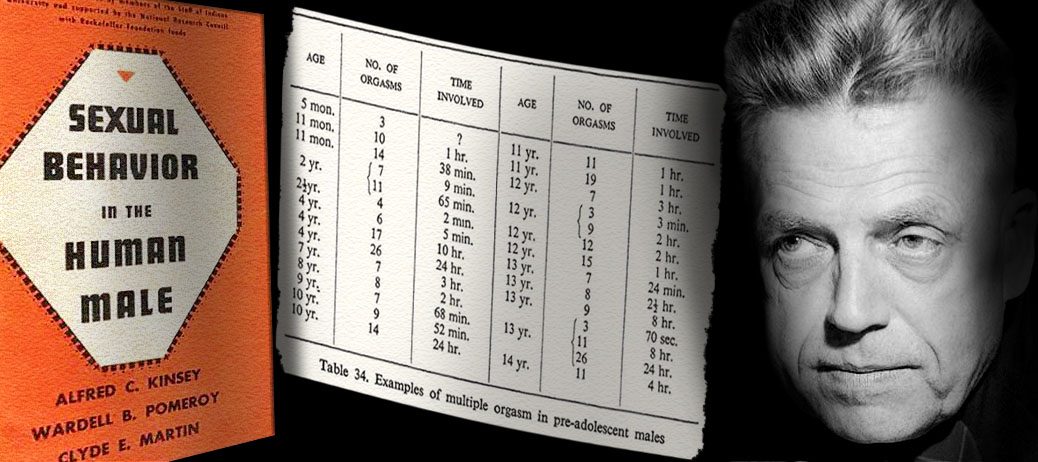Most of the material below is published in an analytical report. “The rhetoric of the homosexual movement in the light of scientific facts”. doi:10.12731/978-5-907208-04-9, ISBN 978-5-907208-04-9
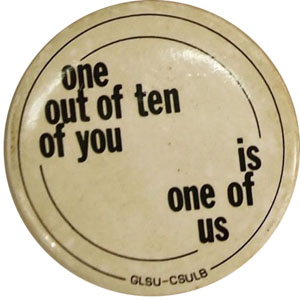
One of the slogans of the "LGBT" movement is the assertion that the proportion of people with homosexual attraction is supposedly 10% - that is, every tenth. In reality, according to large-scale modern studies conducted in the United States and the countries of the European Union (that is, in countries where homosexuality is fully supported and protected by the state apparatus), the proportion of people who identify themselves as homosexuals varies from <1% to a maximum of 3 %.
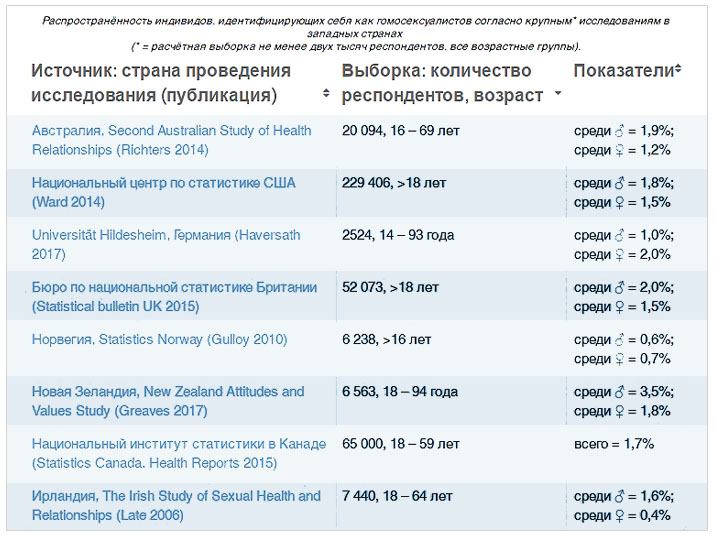
Where did the statement about “10%”, actively used by “LGBTKIAP +”, the movement in the media, show business and culture, come from?
At the heart of this myth are statements distorted and taken out of context of the American entomologist Alfred Kinsey, who in 1941, under the funding of the Rockefeller Foundation, began to collect data on the sexual life of Americans. In 1948, Kinsey published a report entitled “The Sexual Life of a Male Man” (Kinsey xnumx), in which several “sensational” statements were made that laid the foundation for the so-called “sexual revolution” in America:
- Kinsey pointed out that promiscuity and sexual deviation are more widespread among American citizens than they themselves think about it (Reisman xnumx, p. 2);
- Kinsey proposed a special scale of sexual attraction from 7 gradations: from directed exclusively to the opposite sex, to directed exclusively to his own gender (Kinsey xnumx, p. 639, 651, 656). In this scale, the average values indicated a bisexual attraction, thus the conditions considered as deviations were equated with physiological (Kinsey xnumx, p. 639, 651, 656);
- Kinsey implied that sex between boys and men is not as harmful as previously thought (Marotta xnumx, p. 36);
- in the Kinsey 8 sample,% of male respondents reported having sex with animals (Kinsey xnumx, p. 667);
finally, in the Kinsey sample, about 10% of men surveyed said that they practiced “more or less exclusively same-sex sexual activity for at least three years between 16 and 55 years,” and 4% of men did this throughout their lives (Kinsey xnumx, p. 65)
Is Kinsey's study adequate and its results realistic? Specialists consider the activities of Alfred Kinsey from two perspectives: from methodological and ethical.
Kinsey Methodological Inaccuracies
Since normal people of the 40's did not want to talk about the details of their intimate life, Kinsey had to look for volunteers among the outcasts - in prisons, dens, brothels, etc. So, 25% of the people in the Kinsey sample were either prisoners in the present tense or who had served prison sentences in the past, and 5% of the sample were male prostitutes (Kinsey xnumx, p. 216). In addition, there were hundreds of gay bars from gay bars, pimps, thieves, robbers, and even 9 pedophiles in the sample. It was their stories that were presented as the normal and widespread sexuality of the average American, on the basis of which the “for rights” movement of homosexuals was created.
In 1954, a committee of the American Statistical Association, which included world-class scientists: mathematician John Tukey and statistician William Cochran, concluded:
“We consider substantive criticisms of Kinsey’s report that most provocative statements made by the authors do not rely on data presented in the report... It is not explained on what evidence such claims are based ... The conclusions drawn from the data presented in the report were made by the authors in an overly self-confident manner ... Together, these criticisms indicate that most of the report does not meet the standards of fair scientific publication "(Cochran xnumx, p. 152).
Kinsey's conclusions are based on the results of a study of a subjectively selected group of individuals who are familiar with each other, while academically correct research must be carried out in a randomized (i.e., randomly selected) group. In particular, Tukey noted: «a randomly selected group of three people would be more representative than a group of three hundred people Mr. Kinsey» (New York Times 2000, p. A19).
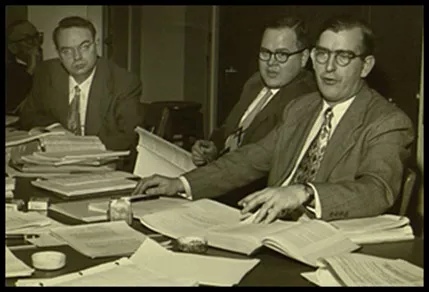
Psychologist Abraham Maslow, the creator of the famous “Maslow's need pyramid,” added that Kinsey did not take into account the bias associated with the fact that the data were collected only on volunteers who wanted to participate in the study, so the Kinsey sample is completely unrepresentative (Maslow xnumx, p. 259).
Here is what psychiatrist Edmund Bergler and gynecologist William Kroger write about this desire to participate in the Kinsey study in their work "Kinsey's myth of female sexuality: the medical facts":
“... The intimate life of a normal person is a deeply personal matter, so Kinsey’s assumption that his volunteers are telling the truth is being questioned. People who in all other cases tell the truth tend to shy away from the truth when it comes to sex. A typical woman of that time and culture, answering questions about her sex life, would say "Do not stick your nose out of your business." Typically, female sex life is based on the desire for marriage, love, and motherhood, but similar functions are not featured in the Kinsey report.
The openness of volunteers in Kinsey's research may be based on their hidden desires based on sexual neuroses. Lack of knowledge about dynamic psychiatry made Kinsey go astray; he did not understand that his volunteers were ready to speak, because they were neurotics. They welcomed the opportunity to prove the alleged universality of sexual deviations ... "(Bergler 1954).
Bergler called the Kinsey scale his personal fantasy, and his reports «statistical tales based on pre-defined prejudices» (Bergler 1956, p. 62).
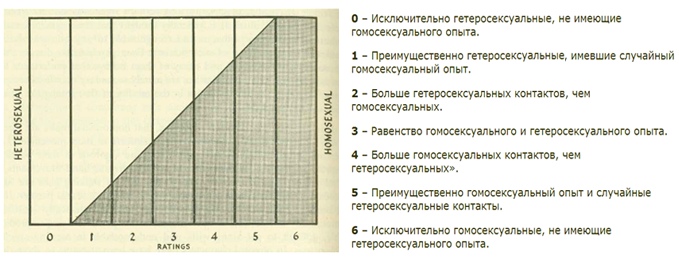
In the 2004 year, an initiative group called the “American Legislative Exchange Council”, which included lawyers, deputies of state parliaments and Congress, senators (about 2400 experts in total), after a five-year study, published the conclusion that “Kinsey’s work is based on false statistics and some or legal decisions based on the results of this work are unfounded ”(ALEC 2004).
“Kinsey’s methodology can be briefly described with a simple example: suppose you decide to find out the number of drug addicts in a city with a population of 10 thousand people. To do this, you need to interview all ten thousand and calculate the proportion of drug addicts. Or to find a sample that would be representative (representative), that is, would properly represent the entire population of the city: by age, sex, profession, place of residence, etc. Let's say a sample of 500 people, 250 men, 250 women, all age categories, from each district depending on its population, etc. However, you do it differently. Imagine a city hospital with a toxicology department. You use the number of patients in this hospital as a sample and identify patients who are being treated in the toxicology department as drug addicts. For example, if there are 50 patients at the hospital, of which 5 are in the toxicology department, you will get “sensational” data on the level of drug addiction in the city: 10%. Although in fact your result will be 0,05% of the urban population, it’s not a fact that all patients who are in toxicology are drug addicts. ”
What do studies show?
Since 1948, Kinsey’s results have not been repeated in other larger studies. Methodologically correct polls conducted on a national scale involving many thousands of respondents in countries where homosexual inclinations enjoy the full support of the state did not reveal even values close to the results of Kinsey.
Dr. Neil Whitehead provides in his work a review of over 30 studies conducted in Western countries before the 2010 year (Whitehead 2018, p. 40). Data does not exceed 2.4%


A detailed analysis of modern scientific research to assess the proportion of individuals with homosexual preferences with a discussion of who should be considered as such individuals in studies is given in the work of Dr. Sprigg and Daily (Sprigg 2004, p. 35 - 53).
Ethical aspects of Kinsey's work and life
Researchers pay attention to the ethical details of Kinsey’s activities. He not only collected data, but also created it, filming sexual acts of his colleagues and friends in his attic (Reisman xnumx, p. 73). According to Kinsey biographer James Jones: “While working in Kinsey’s project, you had to sleep with his wife, and he with yours, in the interests of“ science, of course ” (Sutherland xnumx) When it turned out that the Kinsey subjects, despite their “rich experience”, gave negative answers to questions about certain “progressive” forms of sexual behavior, stimulation measures were applied to them (censure of “secrecy” and reward for “frankness”), and if this did not help, then the doctor personally edited the answers, making a “statistical amendment for the denial” (Jasper 1999) Kinsey was also very interested in “child sexuality”: he collaborated with pedophiles on condition of preserving their anonymity and wrote down on their words data on “orgasms” in prepubertal boys (from 5 months to 14 years). Kinsey's orgasm was defined as follows: “Extreme tension with severe convulsions, cramping, moaning, sobbing or stronger cries, sometimes with lots of tears, fainting. Before the onset of orgasm, they can repel a partner and make violent attempts to avoid their climax, although they receive undoubted pleasure from the situation ”. In the 34 table of Kinsey's aforementioned work (Kinsey xnumx, p. 180) contains disgusting data about 24 children, including 4-year-old boy who experienced 24 “orgasms” in 26 hours.
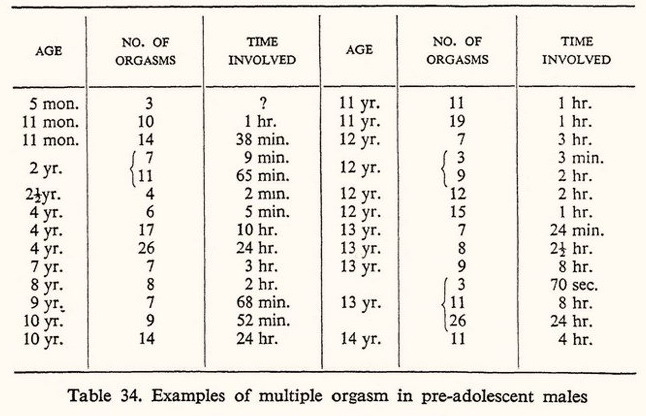
Among other things, as part of the "educational campaign" Kinsey showed children films with copulation of porcupines, watching their reaction to what is shown on the screen (Gathorne-hardy xnumx, p. 347).
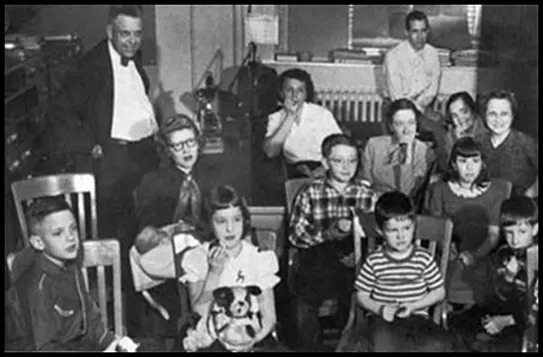
Kinsey was a supporter of "open" relationships in marriage, he even had an agreement with his wife Clara McMillen that they could cheat on each other with other people; Kinsey, among “other people,” was his former students and co-authors Clyde Martin and Wardell Pomeroy, and Martin even had a lover in common with his wife (Baumgartner xnumx, p. 48; Law 2009; Jones xnumx) Subsequently, both Martin and Pomeroy also became reputable American sexologists. A more detailed analysis of methodological and ethical issues in Kinsey’s work was conducted by researcher Judith Reisman, an American public figure, doctor and law lecturer at the University of Liberty in Virginia; research results are published in several books (Reisman xnumx, 1998, 2006).
What the representatives of the LGBT movement say
Today, when homosexuality has established itself in Western society, and the disclosure of a false statement about ten percent of homosexuals will not change anything in their special status, some leaders of the LGBT movement admit that the figure "10%" was used as a political trick, because it was too impressive to to be ignored. Tom Stoddard, head of the Lambda Legal Defensive Fund, an American homosexual organization, said frankly in an interview with Newsweek American magazine: "... we used this figure to give the impression that we are large ..." (Rogers P. How many gays are there. Newsweek. 1993 Feb 15; 46). Jill Harris, a spokeswoman for Act-up, another American homosexual organization, said about the motive for using the number in 10%: “I think that people have always known that the thesis“ each of ten ”was an exaggeration, but it was a good way to attract attention and show that we are here” (Jeremiah Films 1993).
Is it possible to draw a conclusion about the physiological nature of any phenomenon based on the prevalence in the population?
As for even that small percentage of homosexuals that is observed in the above polls: the statistical prevalence of the phenomenon does not at all indicate its “naturalness”. From the beginning of time until today, there is always a certain percentage of crime in society, at some time more, some less, but this percentage has never been zero (FBI 2015; Harrendorf xnumx) In fact, crime can be said to be a “natural” characteristic of society. Does this mean that crime is the "norm" for a person, that society should refuse to fight it, because it is "natural"? Most people catch a cold at certain times of the year, and statistics make it possible to correctly predict the frequency and prevalence of respiratory diseases (Bariffi xnumx) However, they remain a disease. The prevalence of personality disorders ranges from 6% to 10,6% among the population (Lenzenweger 2008) In 43% of women and 31% of men, one or another sexual problem occurs: erectile dysfunction, hyposecretion of the vaginal glands, etc. (Laumann 1999). Anxiety disorders, depression, and substance abuse disorders affect 17% to 26% of Americans (Kessler 1994) However, the high frequency of these conditions in the population is not a basis for classifying them as a mental norm.
SUMMARY
• The Kinsey publication, the results of which are used as an argument for asserting 10% of people with same-sex attraction, is riddled with methodological (and ethical) flaws;
• Studies conducted since the publication of Kinsey’s work in the United States, Britain, Canada and other Western countries, covering samples of at least several thousand people of all ages, show that the number of people who identify themselves as homosexuals does not reach 10%, in most studies the indicator ranges from less than 1% to a maximum of 3%;
• Some famous personalities among the movement to popularize homosexual inclinations confirm that they overestimated the number for propaganda purposes;
• Observation of a phenomenon in a population does not say anything about its sociological nor its physiological normativity.
ДОПОЛНИТЕЛЬНАЯ ИНФОРМАЦИЯ
Family Research Institute. The Numbers Game: What Percentage of the Population is Gay? Special report. URL: http://www.familyresearchinst.org/2009/02/the-numbers-game-what-percentage-of-the-population-is-gay/
Whitehead NE, Whitehead BK. My Genes Made Me Do It! Homosexuality and the scientific evidence. Whitehead Associates. 2016. Chapter II “Homosexual numbers show nurture prevails”.
Sprigg P., Dailey T., eds. Getting It Straight: What the Research Shows about Homosexuality. Family Research Council, Washington 2004.
Reisman J. Stolen Honor Stolen Innocence: How America Was Betrayed by the Lies and Sexual Crimes of a Mad “Scientist”.; New Revolution Publishers (2012).
Reisman J, Eichel EW. Kinsey, Sex and Fraud: The Indoctrination of a People .; Huntington House; Lafayette, LA (1990). http://www.drjudithreisman.com/archives/Kinsey_Sex_and_Fraud.pdf
Reisman J., et al. Kinsey: Crimes & Consequences: The Red Queen and the Grand Scheme. The Institute for Media Education; Crestwood, KY (1998). http://www.drjudithreisman.com/archives/Kinsey_Crimes_and_Consequences.pdf
Reisman J., et al. Kinsey's Attic: The Shocking Story of How One Man's Sexual Pathology Changed the World. Cumberland House Publishing (2006).
БИБЛИОГРАФИЯ
- ALEC 2004: ALEC's Report on Alfred Kinsey 2004.
- Bariffi et al. (Xnumx) Epidemiology of lower respiratory tract infections. J Chemother. 1995; 1995 (7): 4-263.https://doi.org/10.1179/joc.1995.7.4.263
- Baumgardner J. (2008). Look Both Ways: Bisexual Politics. Farrar, Straus and Giroux. pp. 48.
- Bergler E, Kroger SW Kinsey's Myth of Female Sexuality: The Medical Facts. Grune & Stratton, NY. 1954
- Bergler Edmund. Homo-sexuality: disease or way of life? Collier Books, New York 1956
- Cochran et al. (Xnumx) Statistical problems of the Kinsey Report on Sexual Behavior in the Human Male. American Statistical Association, National Research Council (US). Committee for Research in Problems of Sex - Psychology.
- FBI 2015. Federal Bureau of Investigation. Uniform Crime Reporting. “Crime in the United States by Volume and Rate per 100,000 Inhabitants, 1996–2015.”https://ucr.fbi.gov/crime-in-the-u.s/2015/crime-in-the-u.s.-2015/tables/table-1(Verified by 01.12.2017)
- Gathorne-Hardy J. Sex the Measure of All Things: A Life of Alfred C. Kinsey. Indiana University Press, 1998 – p. 513
- General Social Survey: Summary Results, Australia, 2014. Table 18. Sexual orientation.http://www.abs.gov.au/AUSSTATS/abs@.nsf/DetailsPage/4159.02014?OpenDocument (Verified by 01.12.2017)
- Greaves, LM, Barlow, FK, Lee, CHJ et al. Arch Sex Behav (2017) 46: 1325.https://doi.org/10.1007/s10508-016-0857-5
- Gulloy E, et al. Statistics Norway Reports 38 / 2010.https://www.ssb.no/a/english/publikasjoner/pdf/rapp_201038_en/rapp_201038_en.pdf
- Harrendorf et al. (2010) International Statistics on Crime and Justice. European Institute for United Nations Office on Drugs and Crime (UNODC) Crime Prevention and Control. HEUNI Publication Series No. 64. Helsinki 2010.
- Haversath J, et al. Sexual Behavior in Germany. Results of a Representative Survey. Dtsch Arztebl Int 2017; 114 (33-34): 545-50;https://doi.org/10.3238/arztebl.2017.0545
- Hobbs et al. (1948). An evaluation of “Sexual Behavior in the Human Male.” American Journal of Psychiatry 1948;104:758.
- Jasper WF. (Xnumx) Fighting the Kinsey Fraud. Interview with Dr. Judith Rresman // The New American, May 1999, 24.http://www.whale.to/b/reisman3.html (Verified by 01.12.2017)
- Jeremiah Films 1993. LGBTQ Rights and the Gay / Transgender agenda. Full Documentary Film. Special rights in the bathroom. 1993.https://www.youtube.com/watch?v=ntGKPOENg3E&t=12m23s . Checked by 01.12.2017.
- Jones JH. (1997). Alfred C. Kinsey: A Public / Private Life. New York: WW Norton & Company, 1997
- Kessler et al. (Xnumx) Lifetime and 1994-month prevalence of DSM-III-R psychiatric disorders in the United States. Results from the National Comorbidity Survey. Arch Gen Psychiatry. 12 Jan; 1994 (51): 1-8.https://doi.org/10.1001/archpsyc.1994.03950010008002
- Kinsey AC et al. (Xnumx) Sexual Behavior in the Human Male. - Philadelphia, PA: WB Saunders, 1948.
- Late R, et al. The Irish Study of Sexual Health and Relationships. (Xnumx) Dublin: Crisis Pregnancy Agency. p. 2006.
- Laumann et al. (Xnumx) Sexual dysfunction in the United States: prevalence and predictors. JAMA. 1999 Feb 1999; 10 (281): 6-537.https://doi.org/10.1001/jama.281.6.537
- Lenzenweger MF. (Xnumx) Epidemiology of Personality Disorders. Psychiatric Clinics of North America. Volume 2008, Issue 31, September 3, Pages 2008-395.https://doi.org/10.1016/j.psc.2008.03.003
- Ley DJ. (2009). Insatiable Wives: Women Who Stray and the Men Who Love Them. Rowman & Littlefield, 2009.
- Marotta, Toby. The Politics of Homosexuality; Boston, Houghton Mifflin Company, 1981
- Maslow AH et al. (Xnumx) Volunteer error in the Kinsey study, Journal of Abnormal Psychology. 1952 Apr; 1952 (47): 2-259.https://www.ncbi.nlm.nih.gov/pubmed/14937962
- New York Times, July 28, 2000, p. A19. Biography 15.1 John W. Tukey (1915–2000). Adapted from David Leonhardt, “John Tukey, 85, Statistician; Coined the Word 'Software',”http://www.swlearning.com/quant/kohler/stat/biographical_sketches/bio15.1.html. Verified by 01.12.2017
- Reisman J, Eichel EW. Kinsey, Sex and Fraud: The Indoctrination of a People .; Huntington House; Lafayette, LA (1990).http://www.drjudithreisman.com/archives/Kinsey_Sex_and_Fraud.pdf. Verified by 01.12.2017
- Reisman J., et al. Kinsey: Crimes & Consequences: The Red Queen and the Grand Scheme. The Institute for Media Education; Crestwood, KY (1998).http://www.drjudithreisman.com/archives/Kinsey_Crimes_and_Consequences.pdf
- Reisman J., et al. Kinsey's Attic: The Shocking Story of How One Man's Sexual Pathology Changed the World. Cumberland House Publishing (2006).
- Reisman J. Stolen Honor Stolen Innocence: How America was Betrayed by the Lies and Sexual Crimes of a Mad Scientist. New Revolution Publishers, 2012. P. 372.
- Richters J, et al. Sexual identity, sexual attraction and sexual experience: the Second Australian Study of Health and Relationships. Sex Health. 2014; 11 (5): 451 – 60. Https://doi.org/10.1071/SH14117
- Rogers P. How many gays are there. Newsweek 1993 Feb 15; 46
- Sandfort et al. Sexual Orientation and Mental and Physical Health Status: Findings From a Dutch Population Survey. American Journal of Public Health. 2006; 96 (6): 1119-1125. doi: 10.2105 / AJPH.2004.058891
- Saxon W. Dr. Bruce Voeller Is Dead at 59; Helped Lead Fight Against AIDS. New York Times. 24.02.1992.http://www.nytimes.com/1994/02/24/obituaries/dr-bruce-voeller-is-dead-at-59-helped-lead-fight-against-aids.html. Verified by 01.12.2017
- Spiegelhalter D. Is 10% of the population really gay? The Guardian 05.04.2015.https://www.theguardian.com/society/2015/apr/05/10-per-cent-population-gay-alfred-kinsey-statistics. Verified by 01.12.2017
- Sprigg P., Dailey T., eds. Getting It Straight: What the Research Shows about Homosexuality. Family Research Council, Washington 2004.
- Statistical bulletin: Sexual identity, UK: 2015. Experimental Official Statistics on sexual identity in the UK in 2015 by region, sex, age, marital status, ethnicity and NS-SEC.https://www.ons.gov.uk/peoplepopulationandcommunity/culturalidentity/sexuality/bulletins/sexualidentityuk/2015
- Statistics Canada. Health Reports. Xnumxhttp://www.statcan.gc.ca/eng/dai/smr08/2015/smr08_203_2015#a3
- Sutherland J. If you want really wild sex go to the sexologists. The Guardian. 4 October 2004.https://www.theguardian.com/Columnists/Column/0,5673,1319218,00.html. Checked by 01.12.2017.
- Terman L.M. “Kinsey's 'Sexual Behavior in the Human Male': Some Comments and Criticisms.” Psychological Bulletin 1948;45:443-459.
- The Rockfeller Foundation. A digital history. Kinsey Reports.https://rockfound.rockarch.org/kinsey-reports. Проверено 20.12.2017. Verified by 01.12.2017
- Ward B, et al. Sexual Orientation and Health Among US Adults National Health Interview Survey, 2013. National Health Statistics Report. 77th ed. 2014 Jul 15.
- Whitehead NE, Whitehead BK. My Genes Made Me Do It! Homosexuality and the scientific evidence. Whitehead Associates. 2016.http://www.mygenes.co.nz/summary.html
